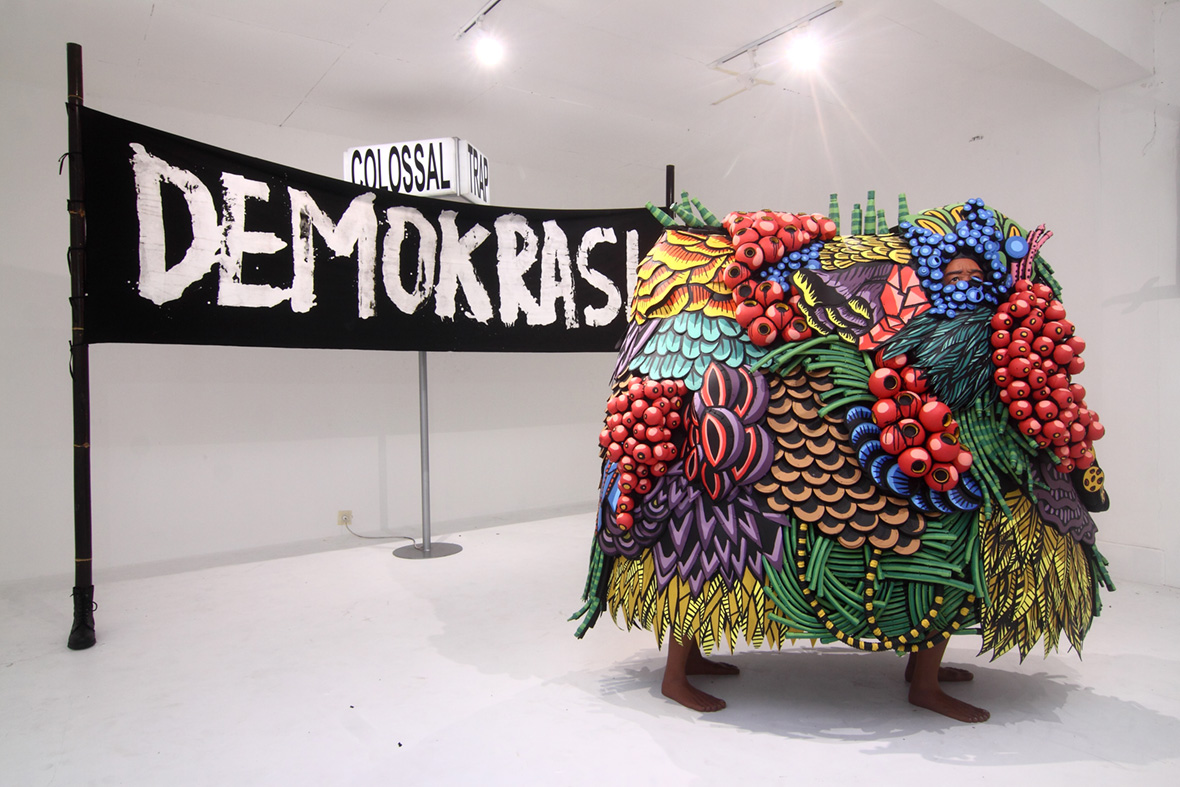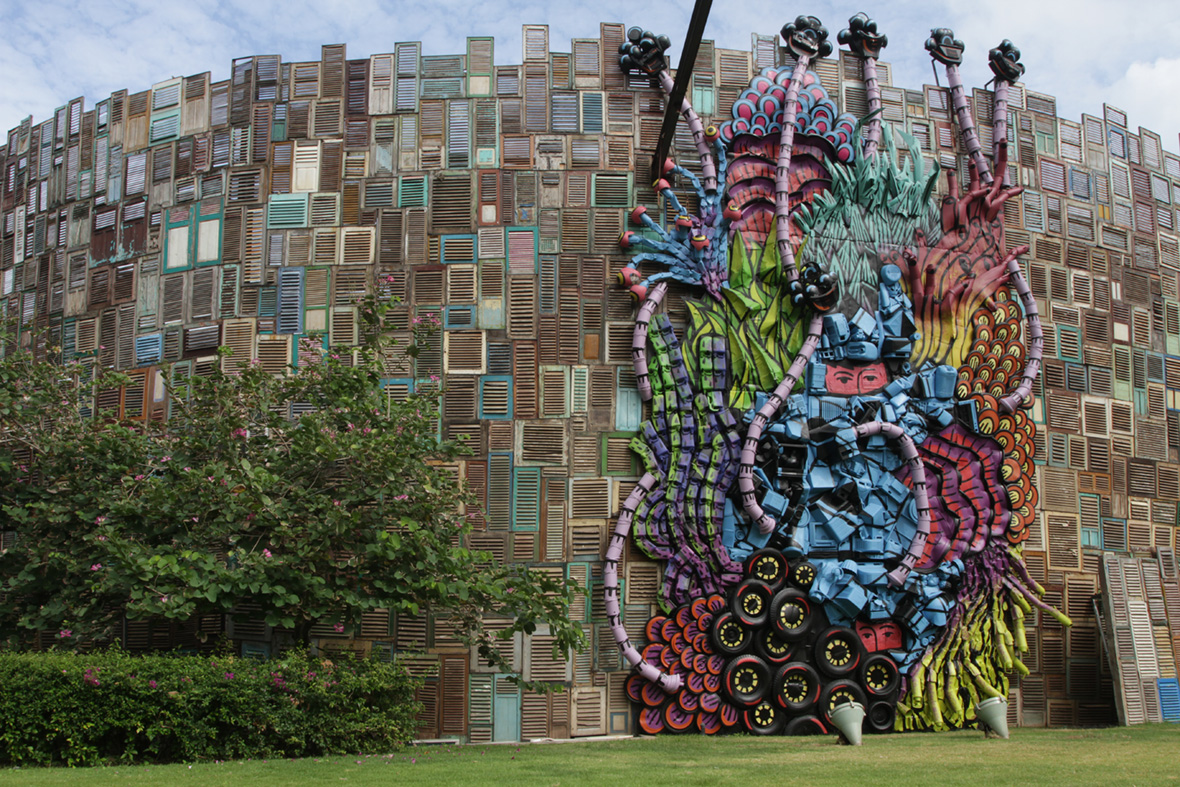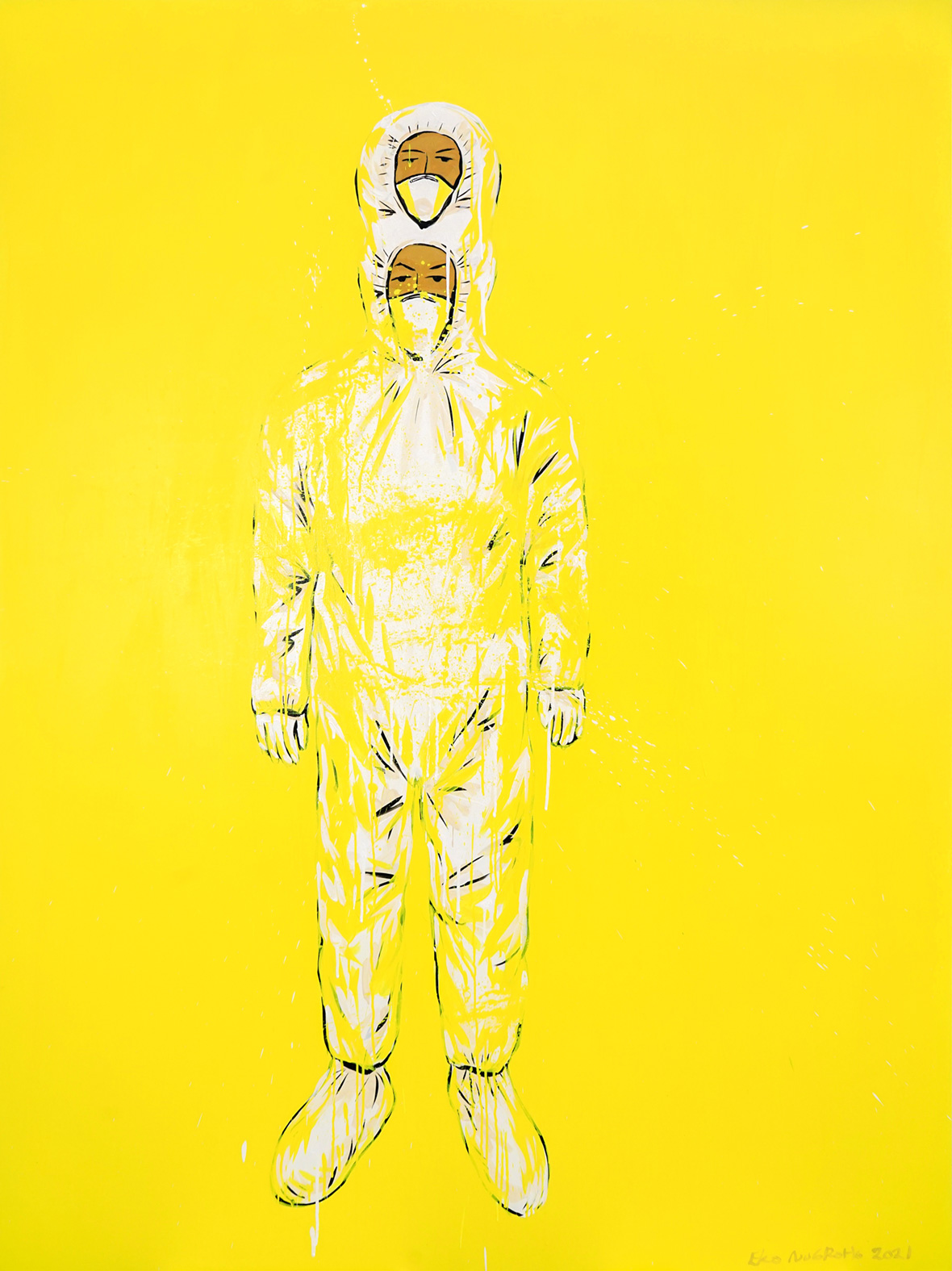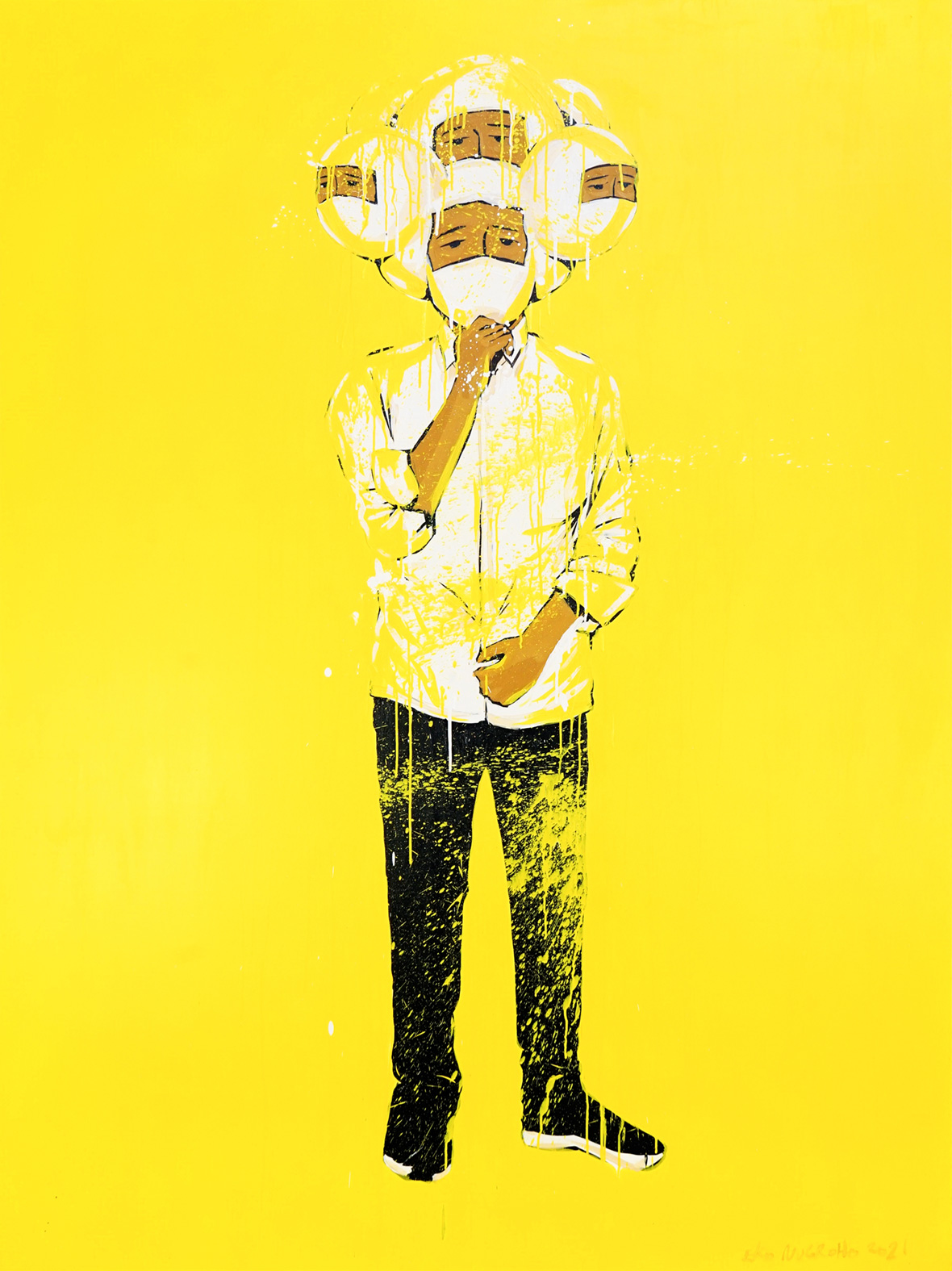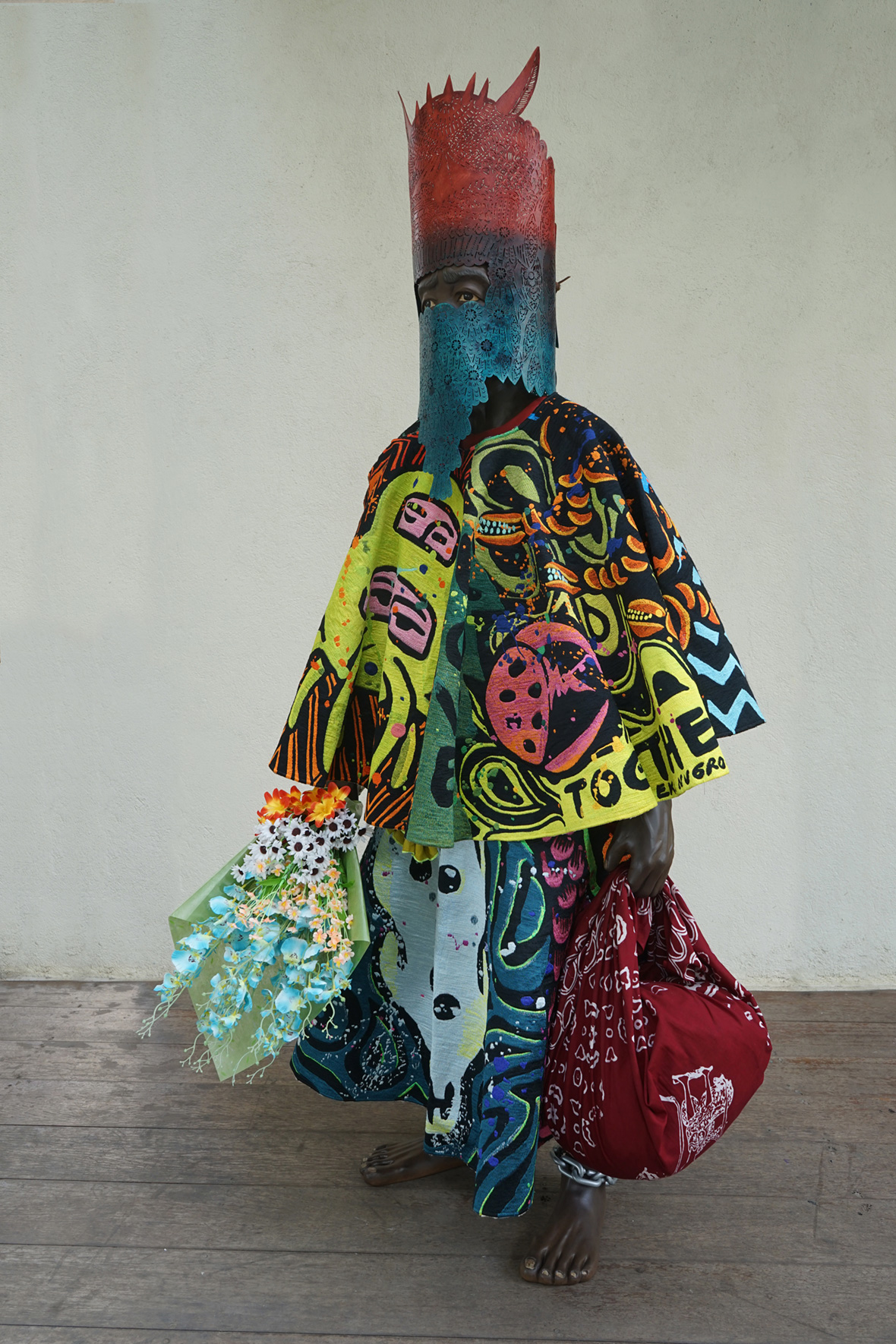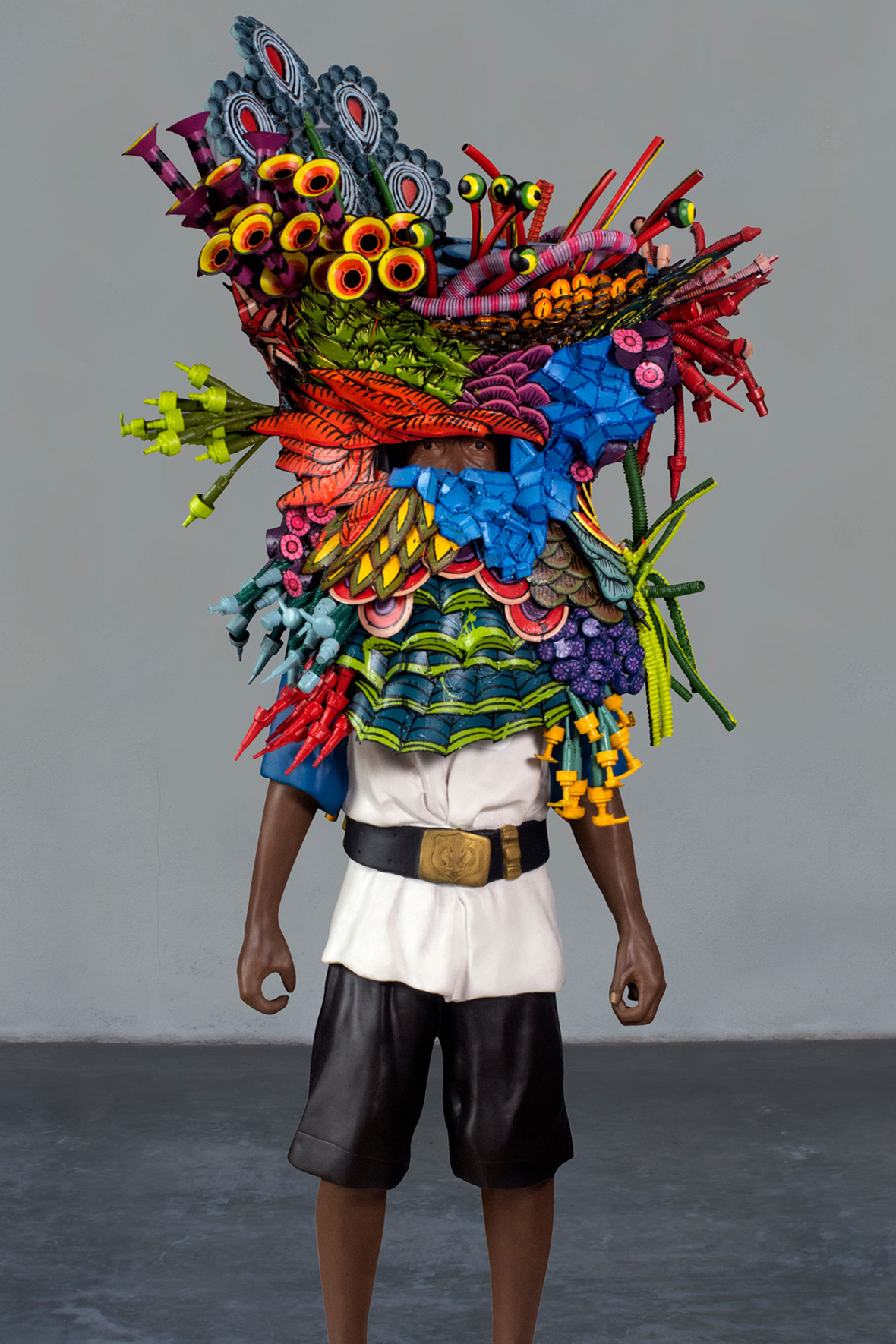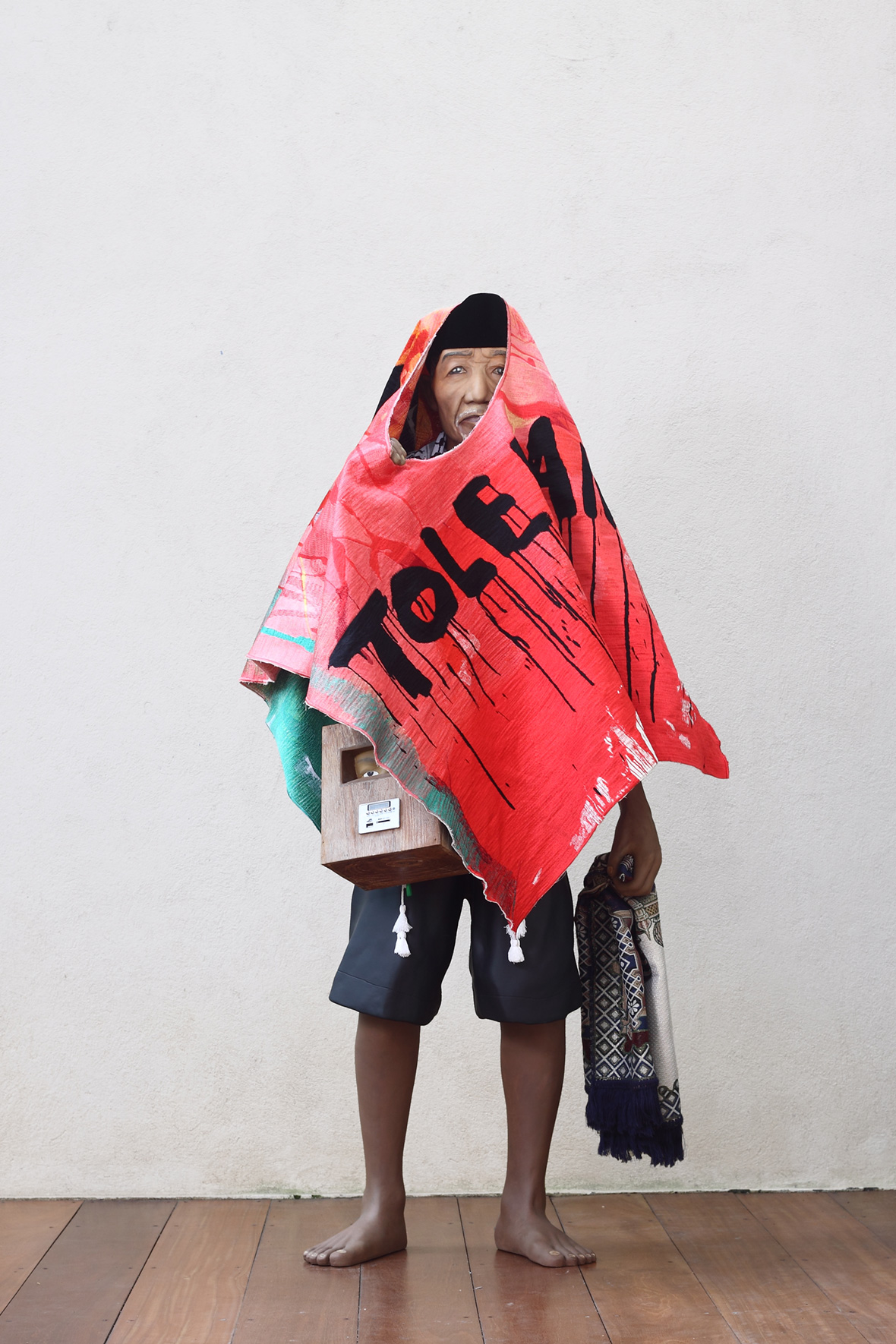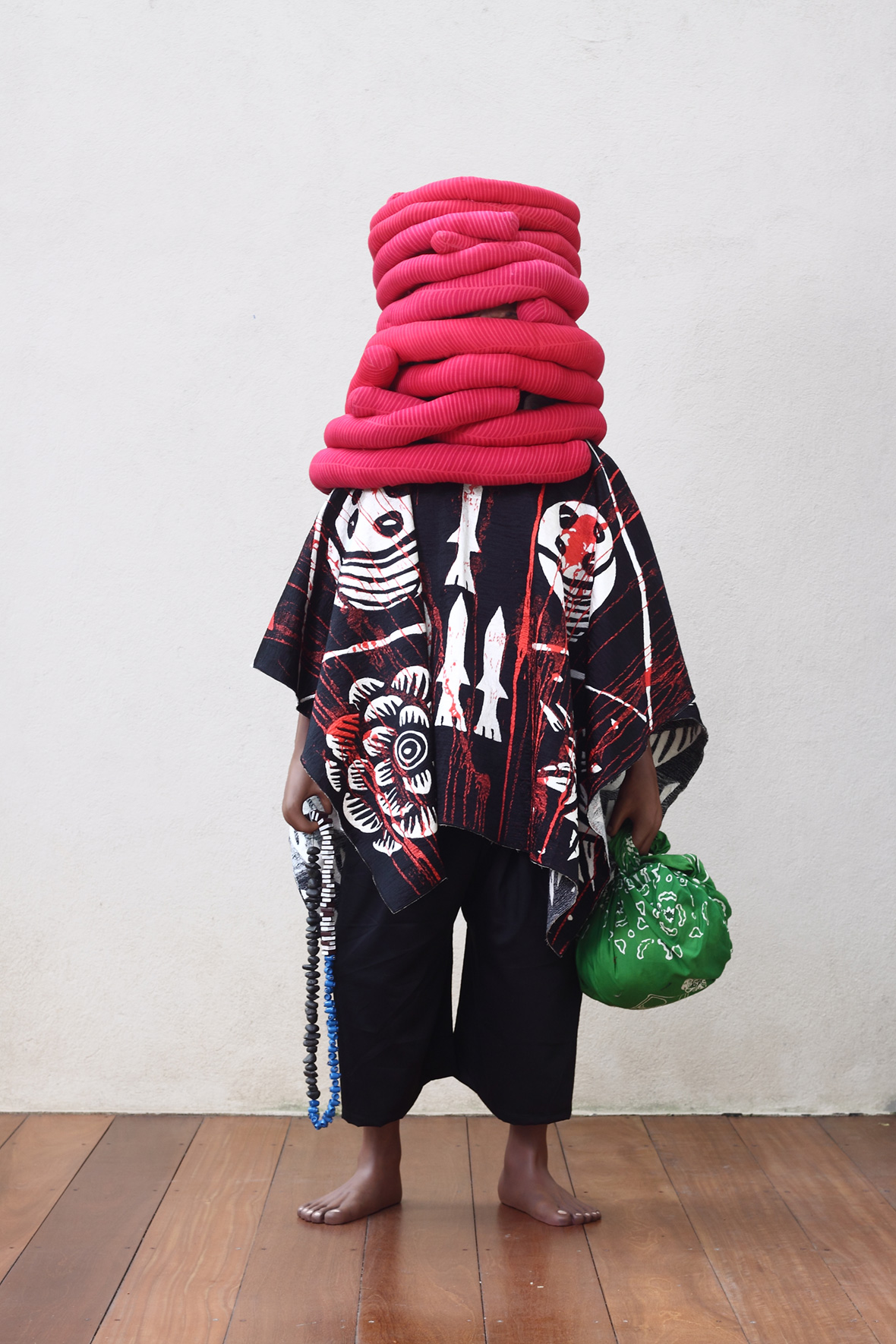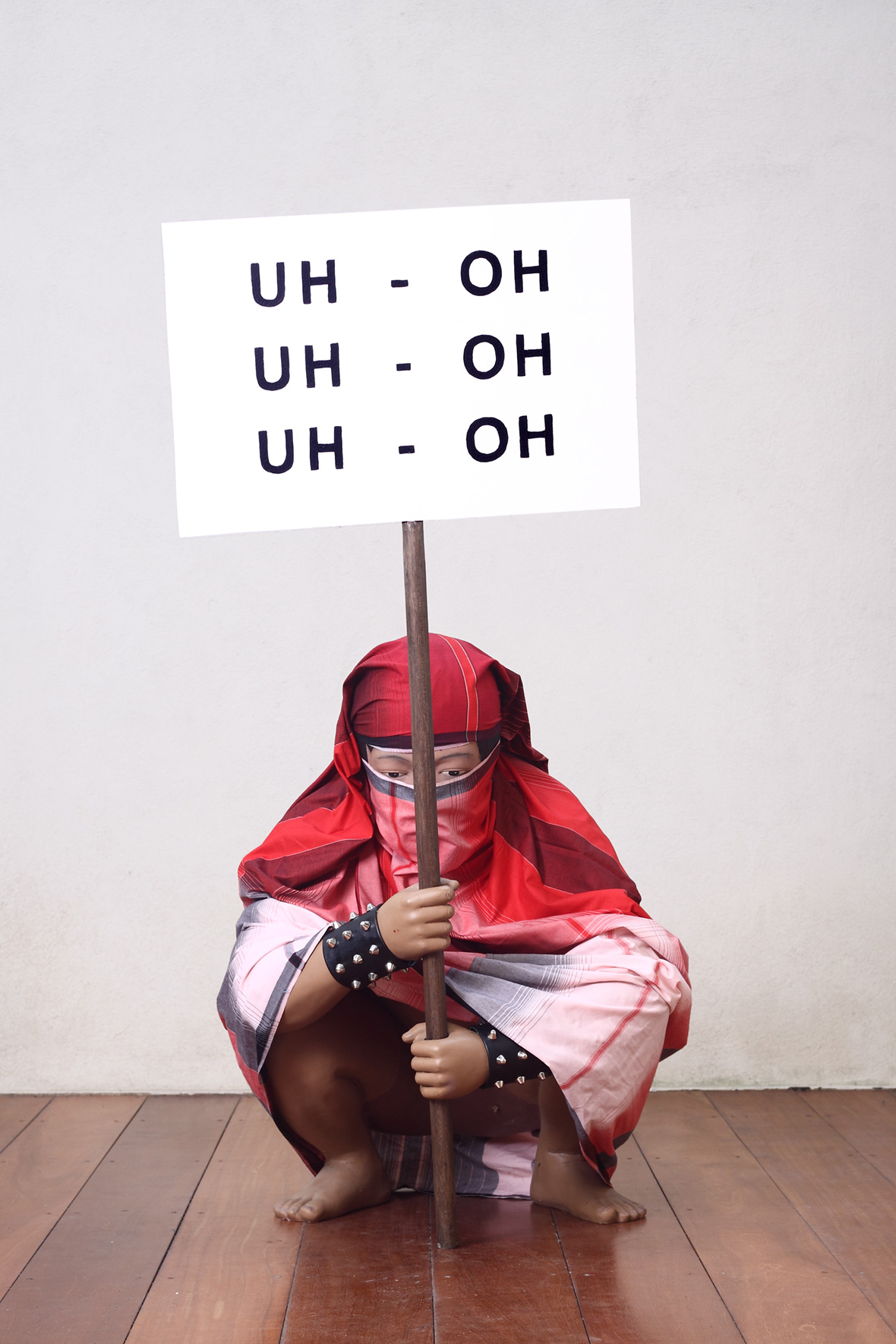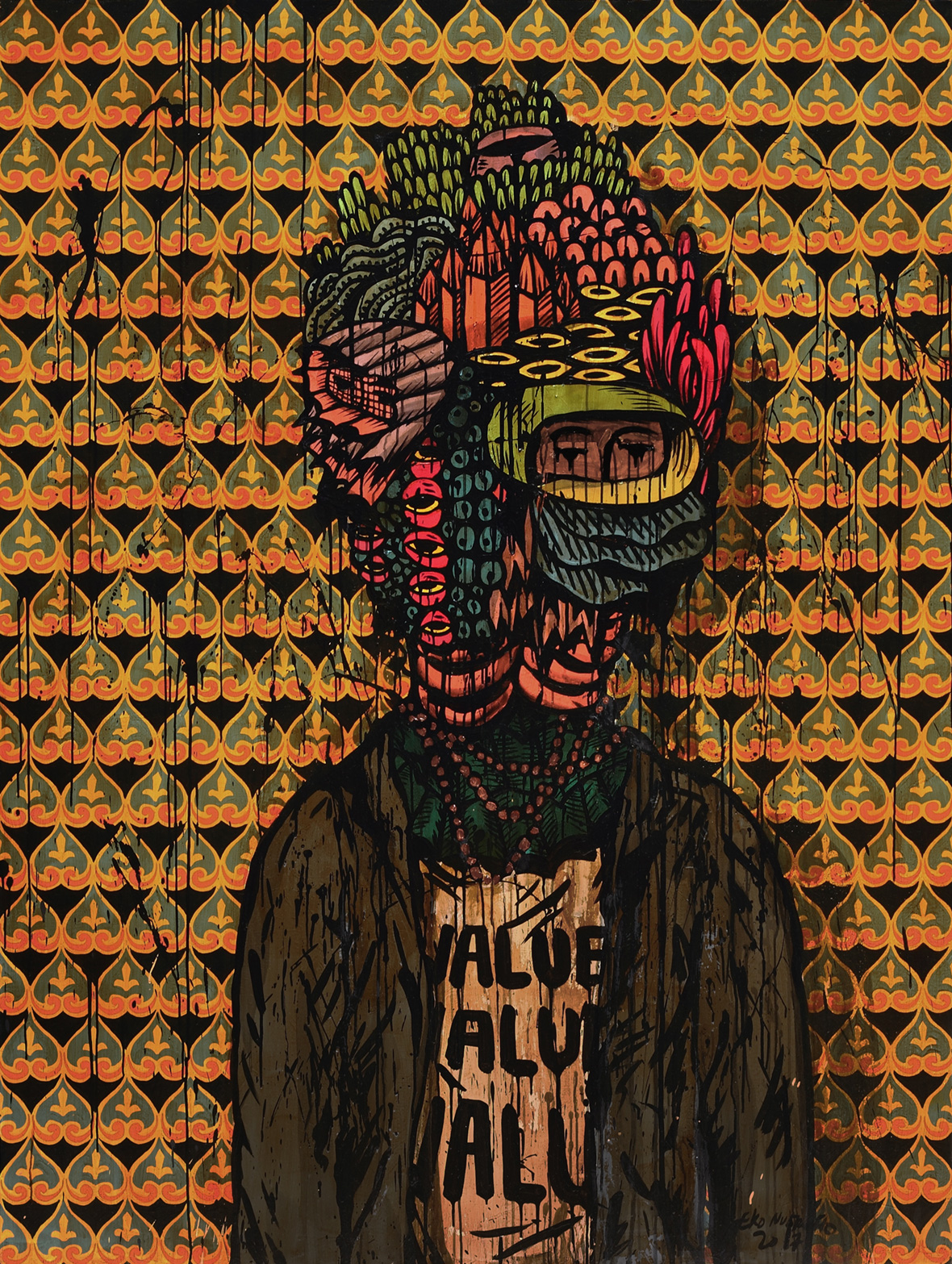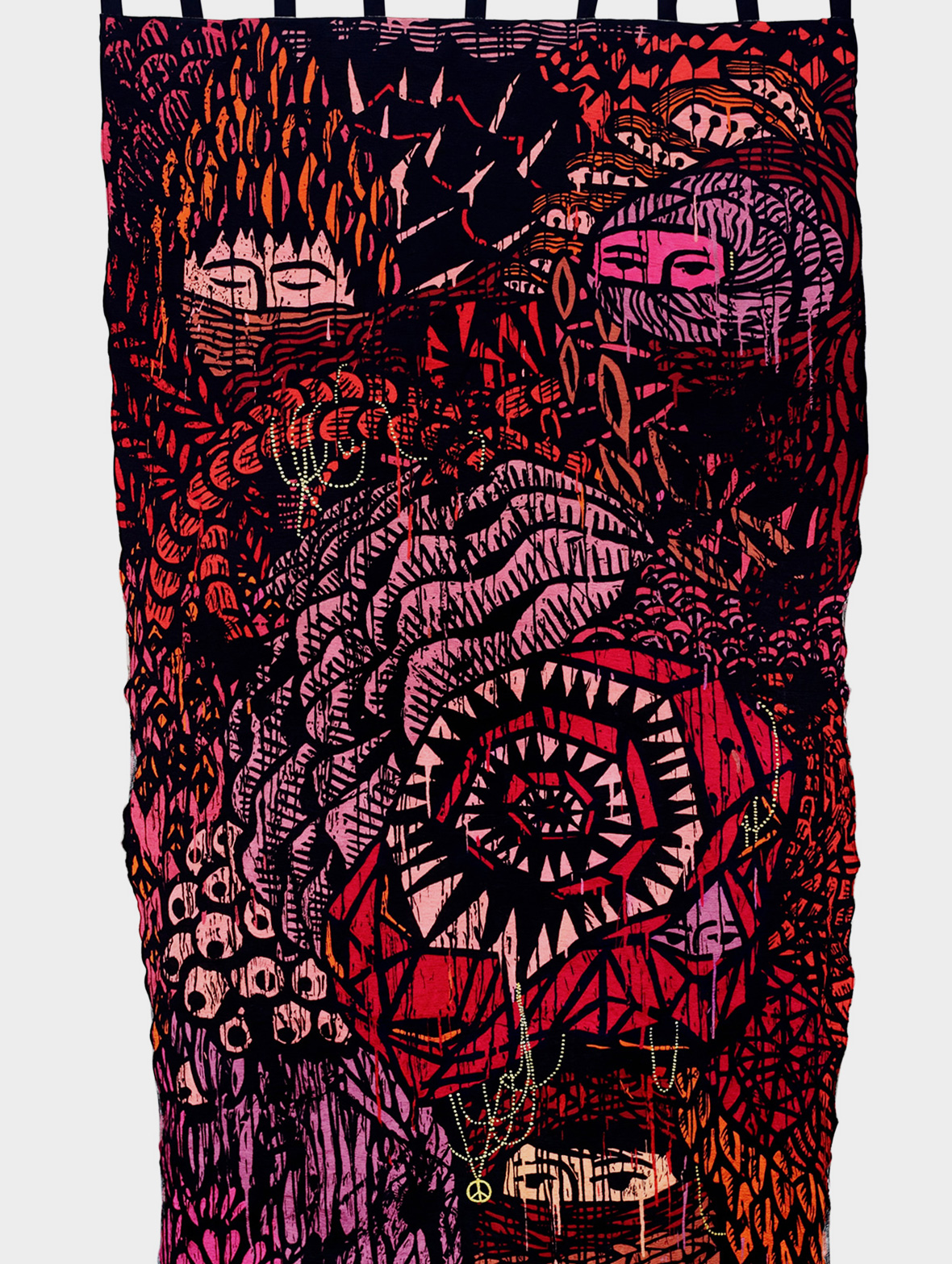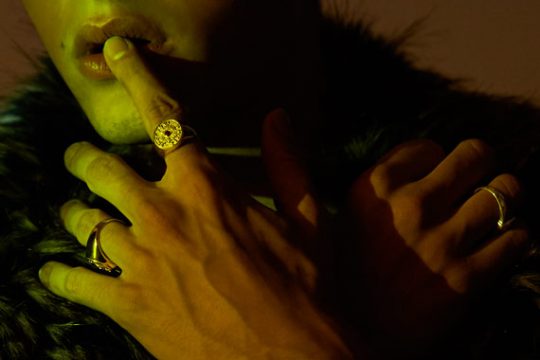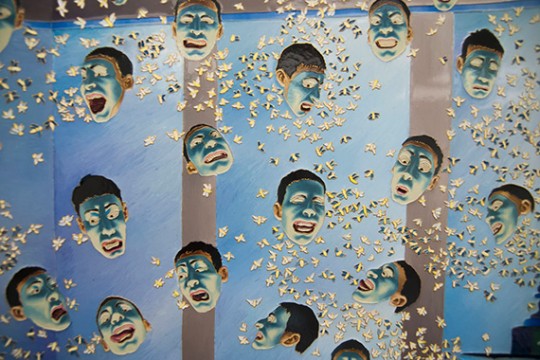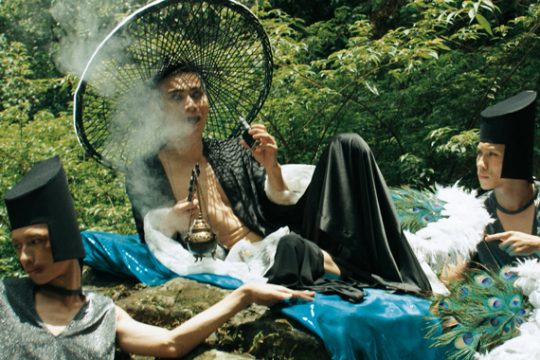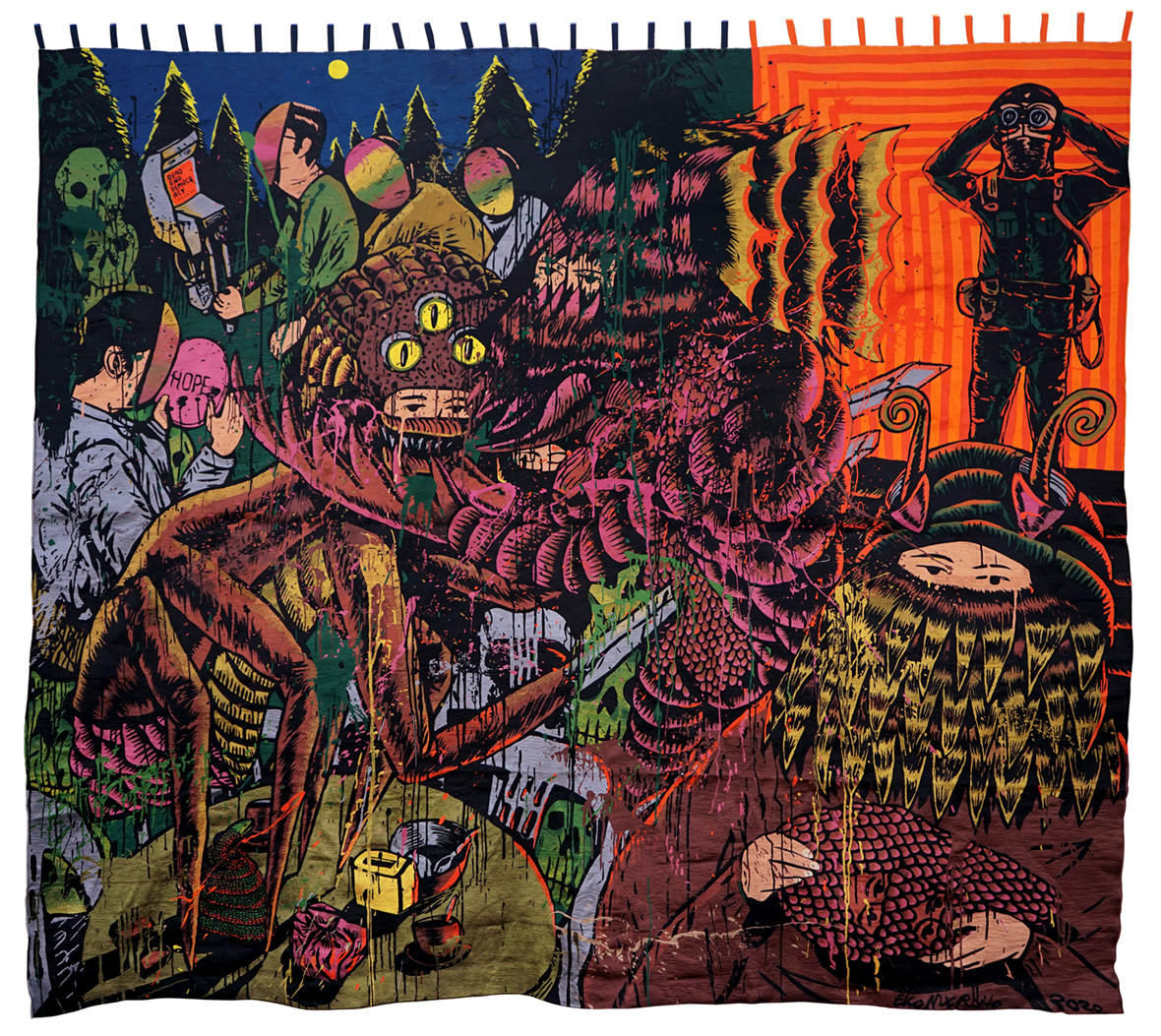
To Eko Nugroho, one of the most acclaimed artists of Indonesia’s reformasi era, art is an inseparable product of an artist’s environment. Having lived through a major financial crisis, mass protests, the fall of a regime, and the democratization of Indonesia, his artistic output has been largely shaped by these experiences. “If the artist lives amidst a very political situation, there are high chances he or she will create works that are very political,” he says. Nugroho’s creativity has flourished as his country transformed.
Spanning paintings, murals, sculptures, installations, embroidery art, and animation, his multidisciplinary work weaves together a plethora of references and traditional Indonesian crafts. His colorful compositions directly reflect his environment, but these reimagined realities are dreamlike, illogical, and even bizarre.
Eko Nugroho 是印尼“改革”(Reformasi)时代最负盛名的艺术家之一。他认为,每位艺术家的作品与他们所处的环境密不可分。他曾亲身经历过金融海啸、大型民众抗议、政权垮台和印尼民主化进程,这些经历都对他的艺术作品有着深远的影响,正如他说所:“如果艺术家生活在一个充满政治色彩的环境中,他们的作品很有可能与此息息相关。”在社会的水深火热之中,Eko 艺术创想却悄然苏醒。
他的作品跨越多重领域,从绘画、壁画、雕塑、艺术装置、刺绣艺术到动画作品,贯穿大量元素,包括了像传统印尼手工艺等等。丰富庞杂的构图折射出他所处的环境,这些重构后的现实如梦似幻,不合逻辑,甚至实属离奇。
A great example is a large piece made of embroidery and painting titled Family Dinner After Democracy. It features references to both Suharto’s regime, in the form of a soldier watching through binoculars, and to the new democratic system in Indonesia, with a man playing on an arcade machine. Even if the latter cannot see because his eyesight is blocked, the message “dead-end democracy” shows up on his screen. The remainder of the piece is dominated by an utterly chaotic scene overtaken by outlandish anthropomorphic beings.
Another example is Carnival Trap #2. It includes a large protest banner made with the word “Demokrasi.” The banner is made of bamboo scaffolds and supported by military boots on both sides. Behind it, there’s a post with a lightbox saying “colossal trap.” And in front of everything, there’s a four-legged humanoid covered in natural patterns. The juxtaposition of the military with democracy is recurrent in Nugroho’s work, and so is a sense of disillusionment with both.
他的大型刺绣和绘画作品《Family Dinner After Democracy》(民主时代的家庭晚宴)便映证了上述所说。画中举着望远镜的士兵代表苏哈托政权,手持街机游戏机的男子则象征了印尼新民主制度。玩游戏机的男子被面罩蒙住双眼,街机屏幕上赫然显现一行文字——“绝望的民主”(dead-end democracy)。剩下的画面一片混乱,充斥着各种古怪的类人型生物。
另一处映证在作品《Carnival Trap #2》(陷阱狂欢#2)中体现,其中包括了“Demokrasi”字样的抗议横幅。其用竹竿撑起,分别插入一只军靴中。横幅后面是一个带有灯箱的柱子,上面写着“巨大的陷阱”(colossal trap)。民主与军队元素经常在 Eko 的作品中并列出现,带来一种魔幻与绝望的压迫感,以及引人深思的谎言意味。
As for the surreal characters with whom he populates his universe, they seem to wander about in dazed confusion. Sometimes they look like mutants; sometimes, they take a more human form. But one thing most of them have in common: they’re almost entirely covered in patchworks of different textures and patterns. Nugroho tends to leave their eyes exposed, allowing them to look back at viewers with piercing gazes. “The eyes in my work represent an intelligent generation, one with vast knowledge, who can see many things,” he explains. “But one that also forgets to listen, to speak kindly, to speak efficiently.”
作品中的角色往往带有超现实主义色彩,他们漫无目的地在画布上徘徊。一些还能依稀看出人的基本轮廓、另一些角色的外表则变得不可名状。Eko 在创作中会刻意露出角色的眼睛,锐利目光,透露着轻蔑和冷漠。他解释说:“在我的作品中,眼睛代表了’聪明人‘,他们知识渊博,见多识广,却总是自大妄为,常常忽略他人的心声,忘记要友善、高效地沟通、忘记聆听他人的感受。”
Born in 1977 in Yogyakarta, Nugroho grew up under the military rule of President Suharto. It was a period of modernization and growth in which Indonesia saw rapid industrialization and unprecedented wealth. These were also dictatorial times, with little to no room for socio-political commentary, especially in the art world.
But, when he entered the Indonesian Institute of the Arts to study for a bachelor’s degree in painting, Indonesia was in turmoil. It was 1997, and Suharto’s promise of prosperity had hit a wall with the Asian financial crisis. Poverty, unemployment, and inflation severely battered the country, and a wave of protests erupted, particularly amidst student groups. It all led to the fall of the regime the following year.
With the political liberalization that ensued in the Reformasi era, artists began addressing topical issues that they weren’t free to broach before. Many artists at the time also began being influenced by lowbrow pop culture, adopted new media formats, and often added a defiant, humorous tone to their works.
Eko 于 1977 年出生于日惹,在苏哈托的军事统治下长大。当时正值印尼现代化和快速增长的时期,国家的工业和财富正在快速积累。但同时,这又是独裁的时代,社会政治评论的空间几乎被彻底扼杀,尤其是在艺术界。
当 Eko 进入印尼艺术学院攻读绘画学位时,印尼社会陷入动荡。那是 1997 年,苏哈托的经济繁荣计划因亚洲金融危机而落空。贫困、失业和通货膨胀严重打击着整个国家,抗议浪潮由此展开,最终导致该政权于次年垮台。
随着改革时代的到来,艺术家终于得以对禁忌话题敞开心扉,他们中一些人受到来自上世纪七十年代低俗艺术(Lowbrow Art,受地下朋克摇滚影响,代表着二十世纪七十年代后期在美国洛杉矶出现的地下视觉艺术运动,代表着民粹主义的艺术运动。大多数低俗艺术为绘画、玩具和雕塑,以幽默的方式表达着政治态度。)的影响,表达出一种挑衅、幽默的态度。
Nugroho mentions many influences for himself, from the music of legendary local pop band Koes Plus to the art of Andy Warhol and Keith Haring. “This era of pop art provided a sense of energy to my works,” he says. “That’s why I began painting in bright colors, something I still do today.” He realized the significance of color early on, seeing it as a device capable of setting the mood and evoking emotions in his audience. “Colors are the agents for feelings and atmosphere. More literally: red can stand for anger, blue for solitude, serenity, or coldness, and yellow can represent joy.”
The ways he wields patterns are similarly intended to conjure certain emotions or imagery. Often, they’re also nods to Mother Nature or traditional Indonesian crafts—whether it be textures inspired by local flora and fauna or motifs found in batik. “I’m interested in how dense, ordered visuals can fill the surfaces of my work,” he says. “If they don’t appear in the main objects, they’re likely to appear in the background.”
Eko 表示自己的创作受过许多影响,包括本地传奇乐队 Koes Plus、安迪·沃霍尔 (Andy Warhol) 和凯斯·哈林 (Keith Haring) 的作品。他说:“波普年代的作品常常令我振奋,这也是我喜欢鲜艳色彩的原因。”早在他创作之初,便意识到了色彩的重要性,将其视为营造氛围、激发情感的工具。“色彩是营造感受和氛围的道具,具体而言,红色是愤怒,蓝色是孤独,而黄色则代表快乐等等。”
同样,他对图案的运用也是为了唤起观众特定的情感或意象,其中绝大多数时候是为了致敬大自然和传统印尼手工艺,包括以本地动植物为灵感设计的纹理以及蜡染图案。他说:“我喜欢用密集、乱中有序的视觉元素来填满画面。这些元素要么覆盖于画面主角之上,要么作为背景出现。”

Other forms of Indonesian art can also be seen in Nugroho’s work. Local costumes and masks inspire the attires worn by his characters, and the wayang, a Javanese shadow puppetry practice, has also appeared in his oeuvre. Nugroho likes to think of these traditions as a permeating tool that brings together the country’s culturally diverse population. He also appreciates that many of these traditions are still around and part of daily life, despite being ancient.
A non-Indonesian art form that became a vital part of Nugroho’s practice is street art, which he began dabbling in during his university years. “What interested me the most [about street art] was the interaction with people passing in front of the wall I was painting,” he says. “These interactions may happen as questions, flattery, anger, and even support since they would give me things like food and drinks. I became interested in how art can connect many distinct elements when it is open to the public.”
Ever since he began making public art, Nugroho was captivated by the effects of community engagement. He expanded the mediums he’d work in and often sought to have an open dialogue with his audience and collaborators. Even when presented in gallery spaces, his work still carries traces of street-art influence. Oftentimes, his gallery showings will involve murals painted directly on the walls. Although, ironically, his gallery murals have a shorter lifespan than his street murals, being that they’re erased as soon as the show ends. This ephemerality amuses him. “I like to work amidst this tension. Between life and death, presence and absence, existence and non-existence,” he says.
Eko 的作品中还会运用到其他形式的印尼艺术。画中角色的服饰灵感来源于当地传统服装和面具设计,印尼传统皮影戏“哇扬戏”(Wayang)也是他的创作灵感之一。Eko 喜欢以这些传统文化作为道具,渴望通过作品表达凝聚多元社会的心愿。令他感到欣慰的是,这些传统虽然历史悠久,但仍然流传至今,并成为人们日常生活中的一部分。
街头艺术,也是 Eko 作品中常见的艺术形式。他早在大学期间便开始接触街头艺术。他认为:“街头艺术最吸引我的是在创作时与路人的互动。这些互动可能是一句提问,可能是赞许或挑斗,甚至是生活中常见的要素,比如一些食物和饮料等。这激发了我的好奇心,尝试在创作中连接众多不同的元素,并与过路人产生互动。”
由于街头艺术与社区联系紧密,渐渐地,Eko 将创作投入到了社区当中。他进一步丰富了自己的创作媒介,并经常去寻求与观众的开放式对话。即使是放在画廊展览的作品,他的作品仍然带有街头艺术影响的痕迹。很多时候,他会直接在展区墙上创作壁画,以此来作为展览作品。不过,展览上的壁画往往比街头壁画寿命更短,展览一旦结束,它们就会被抹去。但 Eko 很喜欢这种短暂的形式。他解释道:“我喜欢这种紧迫感,把生与死、在场与缺席、存在与不存在之间的关系一笔带过。”
To Nugroho, selecting the medium that he’ll create with is the last step in his decision-making process. What starts with a concept in his mind is first realized as a sketch, and only after does the medium he’ll work in come to him. It’s a process that’s rooted in instinct. “The only requirement is that the medium is something close to me, near my environment,” he adds. “I like media that’s easy to find and manipulate.”
For a recent series of embroidery paintings, Nugroho invited a community of embroiderers to complete the artworks by adding a layer of woven yarn on top of his painted canvases. In the hands of the embroiderers, his works transformed entirely, being imbued with unique textures and a unique tactility.
对于 Eko 来说,选择创作媒介是他整个创作过程中的最后一步。创作概念会先被他在脑海中处理成概念草图,然后跟着感觉决定创作媒介,这也是一个追随本能的过程。“唯一的要求是必须是我熟悉的媒介,与我的环境相关的媒介。我喜欢信手拈来的创作媒介,这会让我的创作一气呵成,”他补充道。
在最近的一系列刺绣画中,Eko 邀请了多位刺绣艺术家参与,在他画好的画布上编织一层纱线。在刺绣师的手下,他的作品焕然一新,呈现出独特的纹理和质感。

He also works with waste collectors near his studio to create sculptures with found objects, mainly plastic. “I’m returning waste to the artistic spaces—where it’s also produced—as art pieces,” he says. “Besides the beauty of the artwork itself, there’s also the process and the meaning behind the medium.” Nugroho’s sculptures bring to life his manifestations of chaos. They’re often human-like but wear the strangest attires made of many elements, all charged with symbolism, and carry protest signs with slogans such as “tolerance” and “stop legalize stupidity,” for instance. Because they’re made in human size, it feels as if they’ve crossed over into our dimension—or perhaps they never left it.
Nugroho hopes his upcycling works can serve as a message about sustainability to the community at large. Much of his art revolves around affecting his community in positive ways. For example, the embroiderers he worked with are artisans who’ve fallen on hard times in recent years. But with Nugroho’s assistance, they’re finding additional means of income, and not only that, their handmade crafts are finding new life in a contemporary format. Nugroho also opened DGTMB, a shop to sell prints and designs by local creatives in Yogyakarta, and founded the Eko Nugroho Art Class, a personal development project that teaches students to solve problems, overcome limitations, and find solutions in the most varied areas of life thinking creativity through art.
“Communication is my main strength and interest. I like to produce art as a team,” Nugroho says. He particularly enjoys working with people who do not have a background in art. Still, these collaborators are often experts in their fields, which creates a leveled relationship based on mutual learning.
除此之外,他还和工作室附近的废品回收员合作,拿拾来的废品(主要是塑料品)来制作雕塑。他说:“我想把艺术中产生的废料,再度回收到艺术本身,为作品额外增添一层意义。”
Eko 的雕塑生动地具象了他对混乱的理解。这些人形雕塑披上各式各样的元素、高举着“宽容”和“停止将愚蠢合法化”的言论告示,其背后的象征总比表面上看起来更多。雕塑都按照真人大小创作,现场观看,它们像是造访现实的异度来客——又或许它们一直都存在于这个世界,未曾离开过。
Eko 希望通过这些升级回收的作品,向人们传达可持续发展的信息。他的大部分作品都旨在以积极的方式影响他所在的社区。例如,此前他合作过的刺绣工匠们,都是近年来陷入职业困境的人群。在 Eko 的帮助下,这些刺绣工匠不仅获得了额外的收入,也让自己的手艺以现代的形式,重新焕发新生。除此之外,Eko 还开设了 DGTMB,这是一家专门售卖日惹本地创意人士的印刷作品和设计的商店、以及 Eko Nugroho 艺术班,一个个人发展项目,旨在指导学生解决问题、克服障碍,通过艺术的创意思考,从生活的不同领域寻找解决问题的方案。

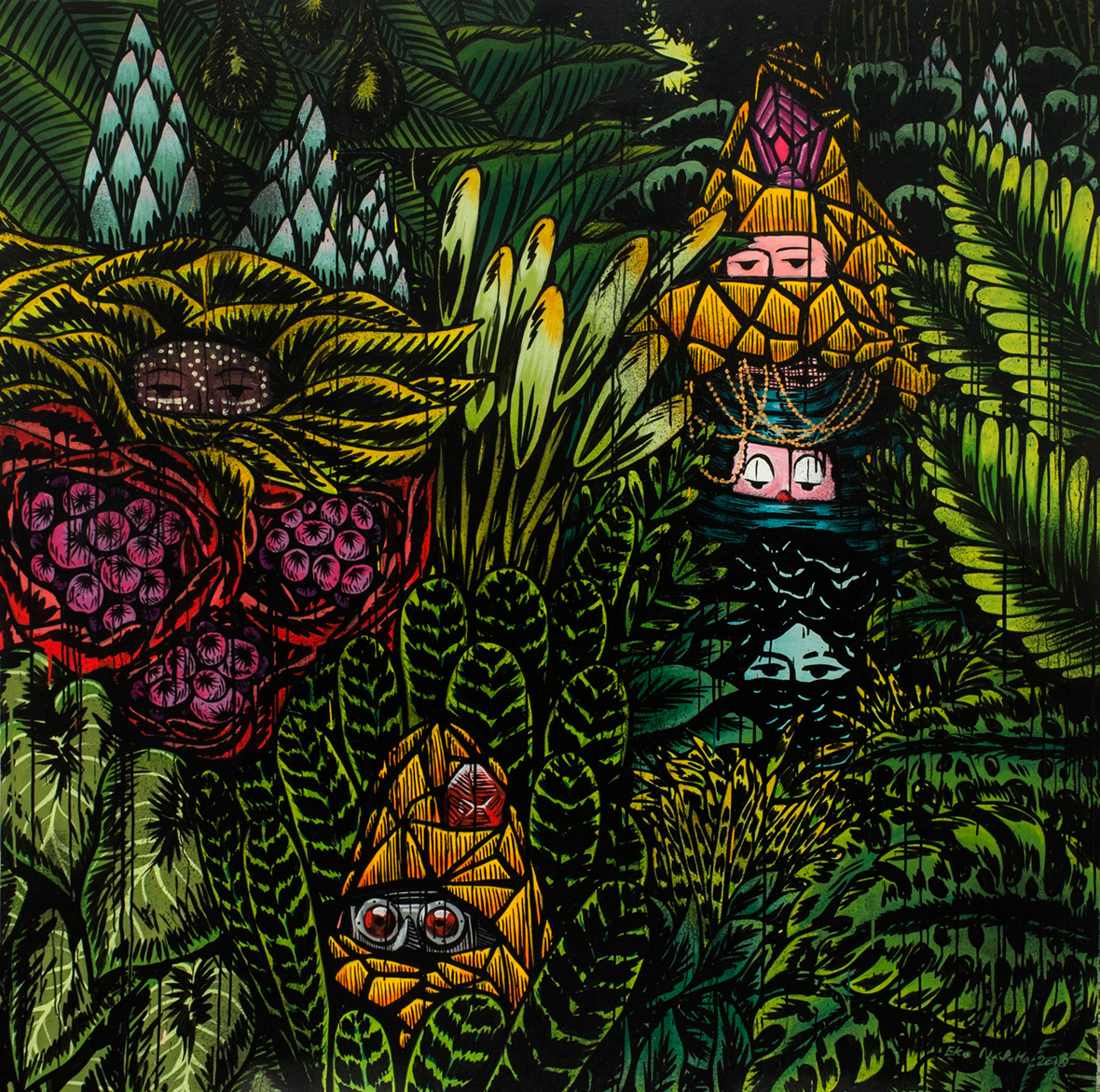
Yogyakarta, or Jogja, as locals affectionately call it, is arguably the cultural center of Indonesia. The city is still the capital of a special region with a ruling sultanate, and it’s the cradle for many of the traditions Nugroho plants in his art. He considers himself lucky to live there and soak in the uniquely creative environment the city offers. “Jogja is an unlimited art laboratory,” he says. “Besides hosting various art platforms, communities, and alternative spaces, Jogja is also a place for discussions and debate. This is what keeps me here.” He also points out that people in Yogyakarta are more receptive to the disruptive nature of art than any other place in the country.
In such an environment, Nugroho can observe the interplay of tradition and modernity as the whole country morphs in front of his eyes. His observations are directly fed into his art. “It’s evident that the artist is inspired, touched, or regulated by the surrounding situations,” he says. “I believe that art serves as an archive of history. Artworks can contain records about a country’s trajectory.”
With each new artwork, Nugroho is filing an entry into his history book. Current issues are ardently recorded, such as the challenges Indonesia has been facing since it became a democracy and, of course, the global pandemic. One of his most recent exhibitions, Destroyed in Peace, recently shown at the Jogja National Museum, featured paintings of characters in face masks and hazmat suits and a sculpture formed by several skulls to symbolize the death toll of Covid-19. The absurdity in his world is not too different from the absurdity in our world. In both, we find war, conflict, division, and death. But, in his world, as in ours, there’s hope. It lies in the watchful eyes of the people.
日惹又被当地人亲切地称为“Jogja”,这里可以说是印尼的文化中心。这座城市仍然是日惹苏丹国这个特区的首府,也是 Eko 在艺术创作中借鉴的众多传统的发源地。他觉得自己很幸运,能在这座城市生活,沉浸于这座城市独特的创意环境之中。他说:“日惹是一个无限的艺术实验室。这里除了有各种艺术平台、社区和非主流空间,也充满了对话和讨论。这也是我一直留在这里的原因。”他还指出,和印尼其他地方的人相比,日惹人对于颠覆性的艺术更包容。
在这样的环境下,Eko 得以亲眼见证这个国家的变迁,观察着传统与现代的交错,而这些观察也被他直接加入自己的艺术创作中。他说:“毋庸置疑,艺术家都会受到周围环境的启发、触动或影响。我觉得艺术就是记录历史的档案。艺术作品可以记录一个国家的历史轨迹。”
每一件新的作品都是 Eko 的个人艺术史册中的新篇章,是当前社会在他眼中的方方面面的体现,例如印尼自成为民主国家以来所面临的挑战,以及当前影响全球的新冠疫情。他最近的一个展览《Destroyed in Peace》(和平摧毁)最近在日惹国家博物馆展出,其中包括戴着面具和防护服的人物肖像画,以及象征死亡人数的骷髅雕塑。现实世界的荒谬,其实并不亚于他的作品。这两个世界同样充满战争、冲突、分裂和死亡。但同样,无论是在他的画中,或是现实世界里,希望依然存在,它就存在于人们警惕的注视中。
Like our stories? Follow us on Facebook and Instagram.
Website: ekonugroho.or.id
Instagram: @ekonugroho_studio
Contributors: Tomas Pinheiro, Lucas Tinoco
Chinese Translation: Olivia Li

